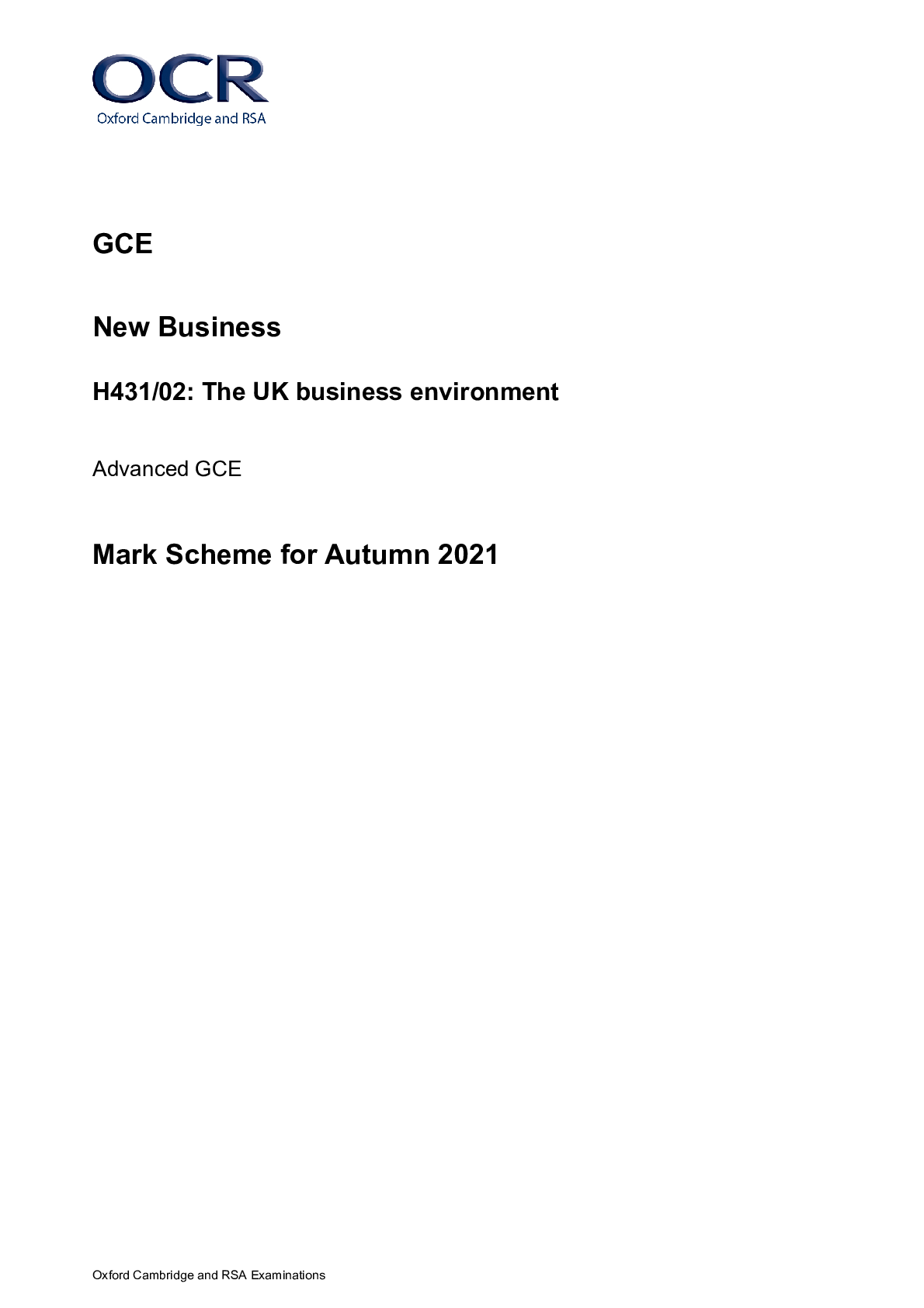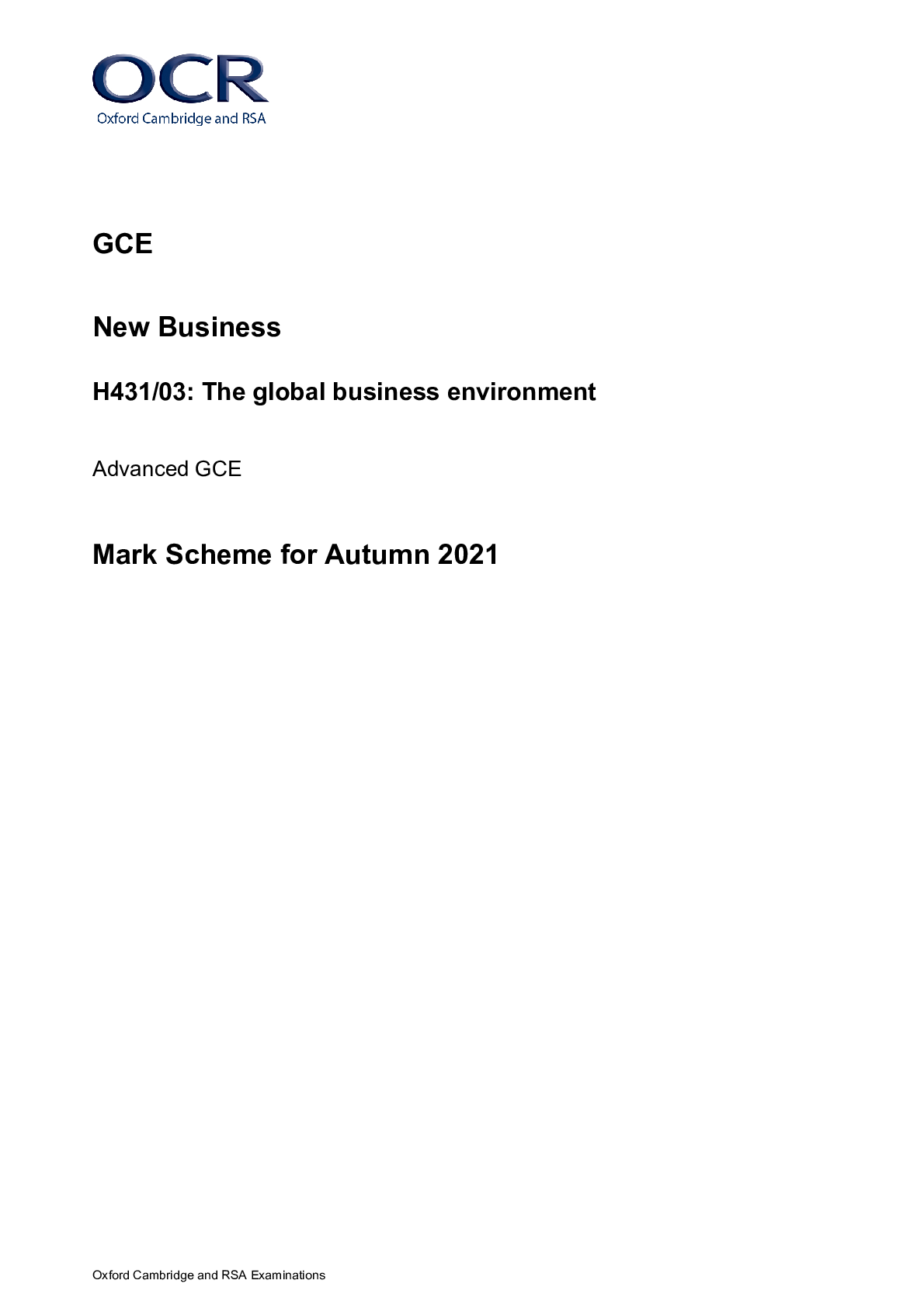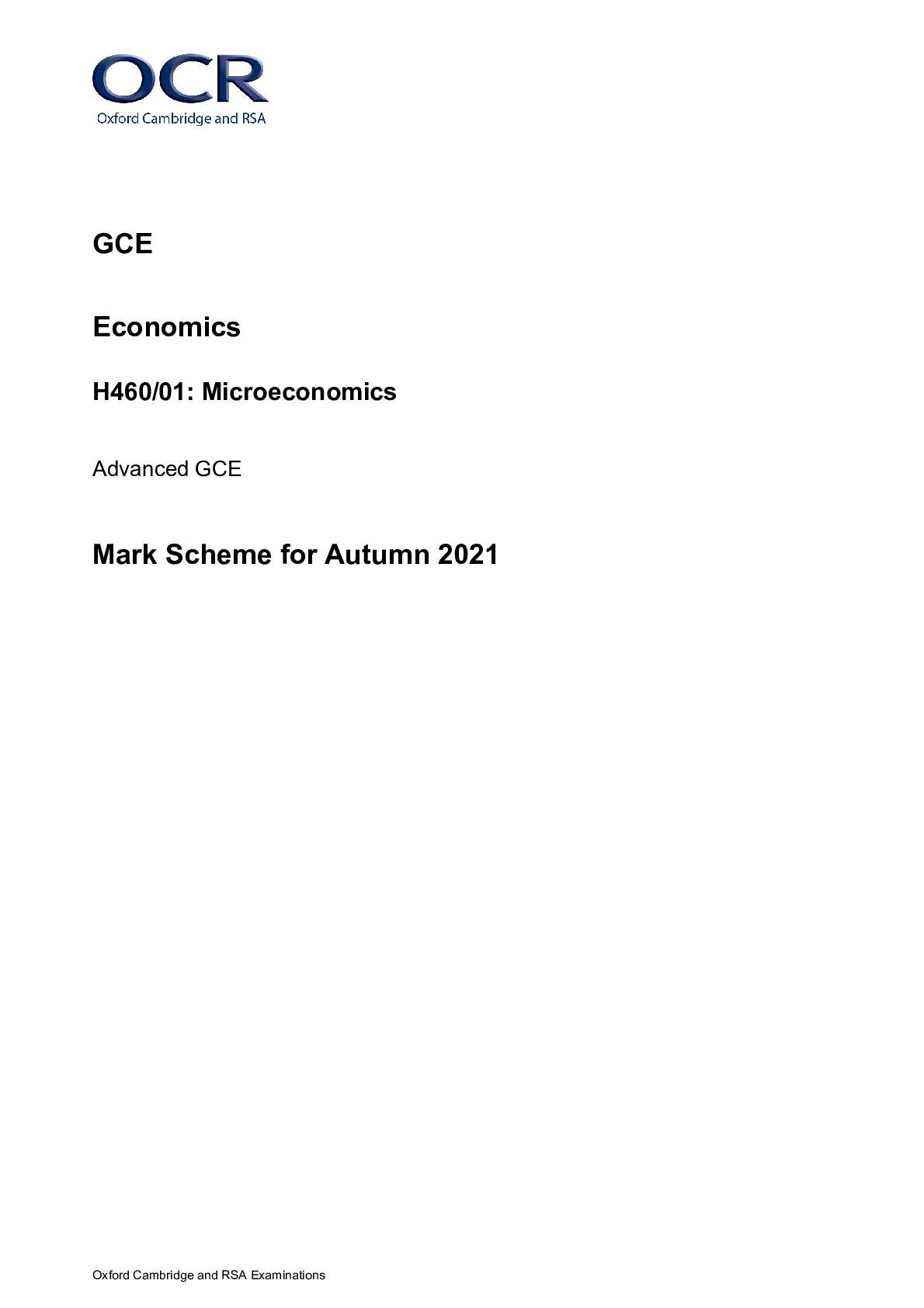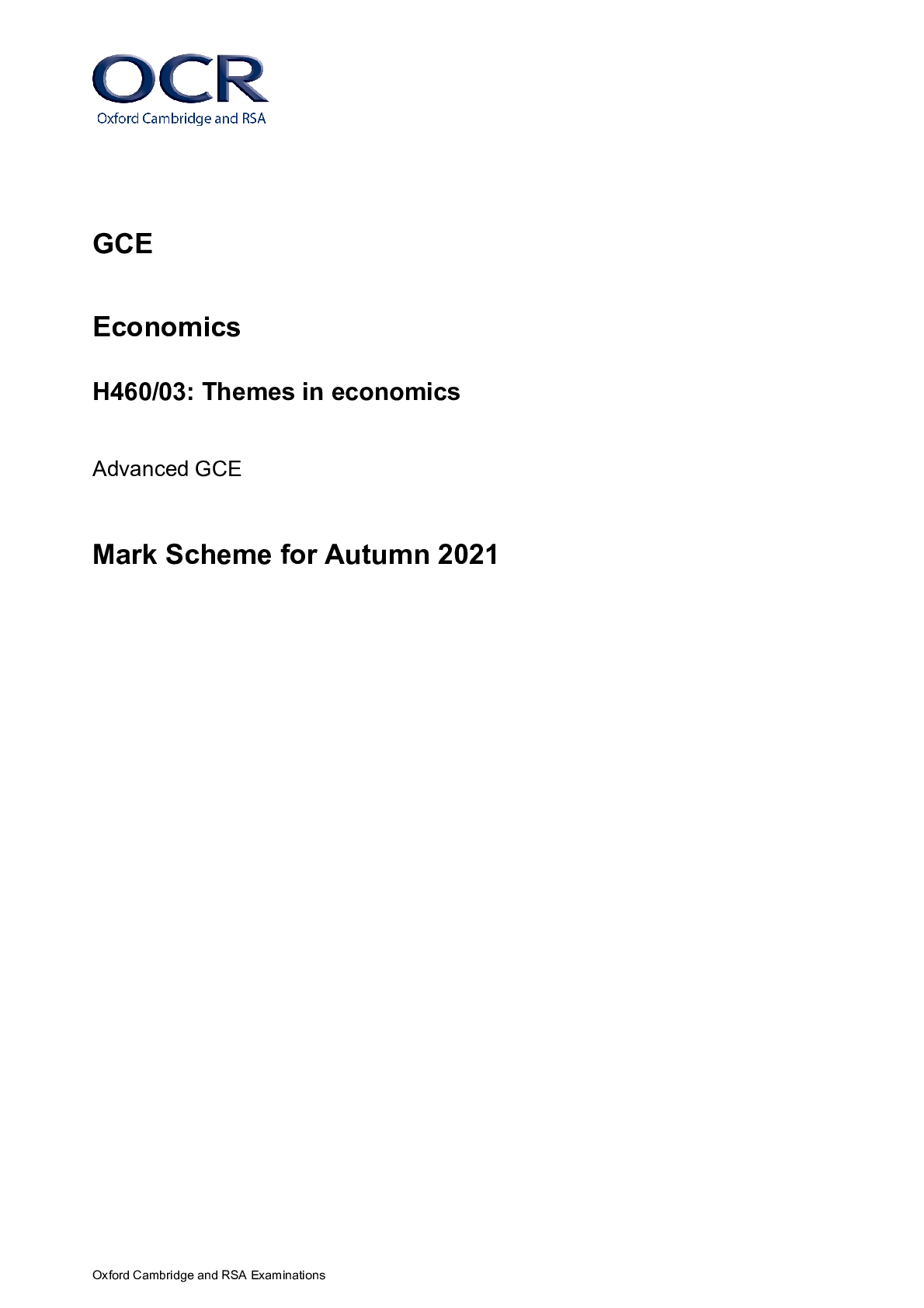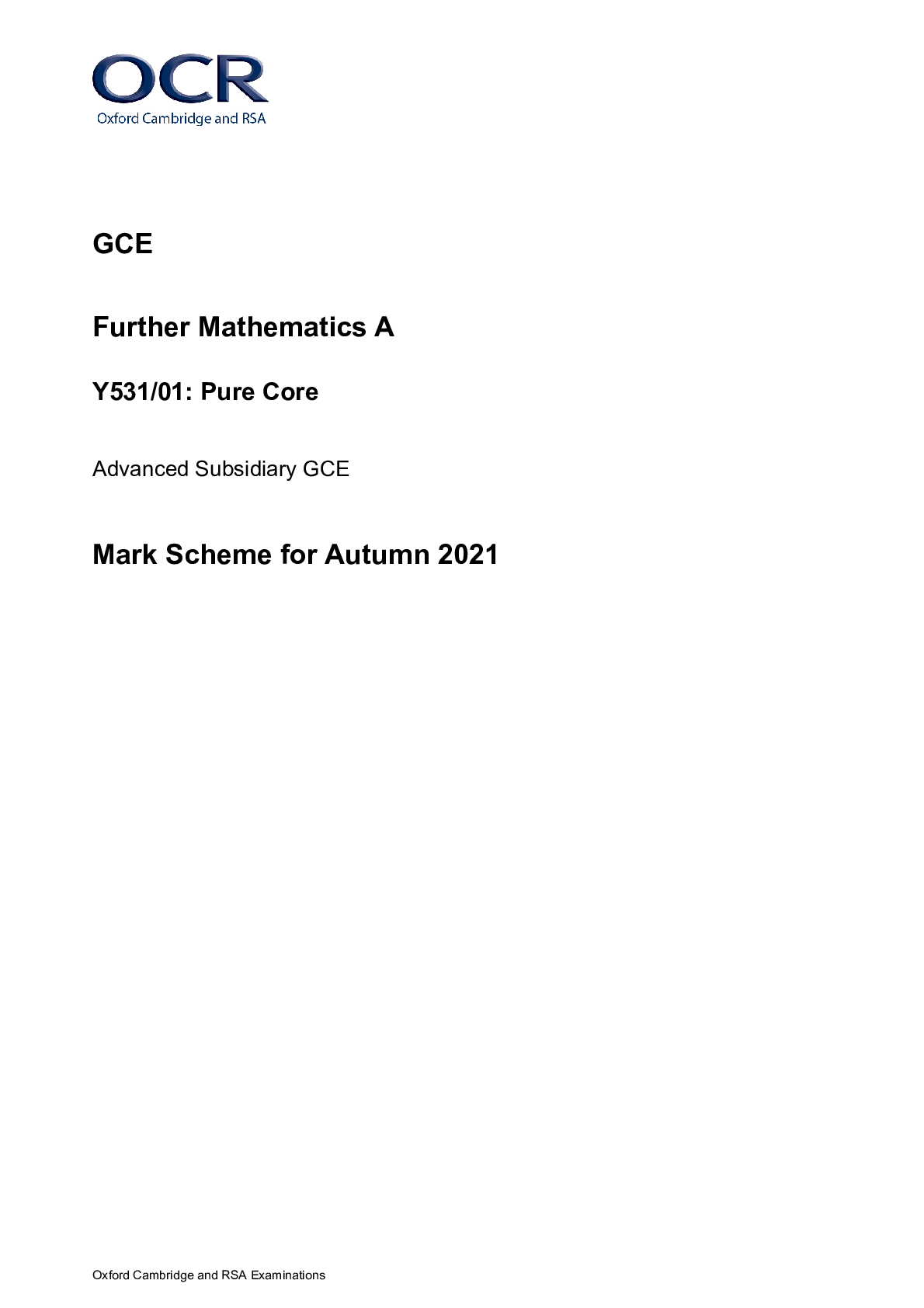Sociology > MARK SCHEME > GCE Sociology H580/03: Debates in contemporary society Advanced GCE Mark Scheme for November 2020 (All)
GCE Sociology H580/03: Debates in contemporary society Advanced GCE Mark Scheme for November 2020
Document Content and Description Below
GCE Sociology H580/03: Debates in contemporary society Advanced GCE Mark Scheme for November 2020 Oxford Cambridge and RSA Examinations GCE Sociology H580/03: Debates in contemporary society... Advanced GCE Mark Scheme for November 2020Oxford Cambridge and RSA Examinations OCR (Oxford Cambridge and RSA) is a leading UK awarding body, providing a wide range of qualifications to meet the needs of candidates of all ages and abilities. OCR qualifications include AS/A Levels, Diplomas, GCSEs, Cambridge Nationals, Cambridge Technicals, Functional Skills, Key Skills, Entry Level qualifications, NVQs and vocational qualifications in areas such as IT, business, languages, teaching/training, administration and secretarial skills. It is also responsible for developing new specifications to meet national requirements and the needs of students and teachers. OCR is a not-for-profit organisation; any surplus made is invested back into the establishment to help towards the development of qualifications and support, which keep pace with the changing needs of today’s society. This mark scheme is published as an aid to teachers and students, to indicate the requirements of the examination. It shows the basis on which marks were awarded by examiners. It does not indicate the details of the discussions which took place at an examiners’ meeting before marking commenced. All examiners are instructed that alternative correct answers and unexpected approaches in candidates’ scripts must be given marks that fairly reflect the relevant knowledge and skills demonstrated. Mark schemes should be read in conjunction with the published question papers and the report on the examination. © OCR 2020H580/03 Mark scheme November 2020 11. Annotations Annotation Meaning Knowledge and Understanding point Developed Point: fully explained in a relevant way Underdeveloped: Partially explained, but requiring more depth Anecdotal/ common sense/ asociological point Application/interpretation. On questions 1 and 2: clear reference to source. On other questions: explicit application to the question (optional) Critical Evaluation point Unsubstantiated/ undeveloped/ implicit / accurate without explanation/ substantiation Unclear/confused/lacks sense/inaccurate Repetition Irrelevant material/ not clearly focused on question set Juxtaposition of alternative theories/ideas without direct/ explicit evaluation 12. Subject Specific Marking Instructions INTRODUCTION Your first task as an Examiner is to become thoroughly familiar with the material on which the examination depends. This material includes: • the specification, especially the assessment objectives • the question paper and its rubrics • the texts which candidates have studiedH580/03 Mark scheme November 2020 • the mark scheme. You should ensure that you have copies of these materials. You should ensure also that you are familiar with the administrative procedures related to the marking process. These are set out in the OCR booklet Instructions for Examiners. If you are examining for the first time, please read carefully Appendix 5 Introduction to Script Marking: Notes for New Examiners. Please ask for help or guidance whenever you need it. Your first point of contact is your Team Leader. USING THE MARK SCHEME Please study this Mark Scheme carefully. The Mark Scheme is an integral part of the process that begins with the setting of the question paper and ends with the awarding of grades. Question papers and Mark Schemes are developed in association with each other so that issues of differentiation and positive achievement can be addressed from the very start. This Mark Scheme is a working document; it is not exhaustive; it does not provide ‘correct’ answers. The Mark Scheme can only provide ‘best guesses’ about how the question will work out, and it is subject to revision after we have looked at a wide range of scripts. The Examiners’ Standardisation Meeting will ensure that the Mark Scheme covers the range of candidates’ responses to the questions, and that all Examiners understand and apply the Mark Scheme in the same way. The Mark Scheme will be discussed and amended at the meeting, and administrative procedures will be confirmed. Co-ordination scripts will be issued at the meeting to exemplify aspects of candidates’ responses and achievements; the coordination scripts then become part of this Mark Scheme. Before the Standardisation Meeting, you should read and mark in pencil a number of scripts, in order to gain an impression of the range of responses and achievement that may be expected. Please read carefully all the scripts in your allocation and make every effort to look positively for achievement throughout the ability range. Always be prepared to use the full range of marks.H580/03 Mark scheme November 2020 USING THE MARK SCHEME Please study this Mark Scheme carefully. The Mark Scheme is an integral part of the process that begins with the setting of the question paper and ends with the awarding of grades. Question papers and Mark Schemes are developed in association with each other so that issues of differentiation and positive achievement can be addressed from the very start. This Mark Scheme is a working document; it is not exhaustive; it does not provide ‘correct’ answers. The Mark Scheme can only provide ‘best guesses’ about how the question will work out, and it is subject to revision after we have looked at a wide range of scripts. The Examiners’ Standardisation Meeting will ensure that the Mark Scheme covers the range of candidates’ responses to the questions, and that all Examiners understand and apply the Mark Scheme in the same way. The Mark Scheme will be discussed and amended at the meeting, and administrative procedures will be confirmed. Co-ordination scripts will be issued at the meeting to exemplify aspects of candidates’ responses and achievements; the coordination scripts then become part of this Mark Scheme. Before the Standardisation Meeting, you should read and mark in pencil a number of scripts, in order to gain an impression of the range of responses and achievement that may be expected. Please read carefully all the scripts in your allocation and make every effort to look positively for achievement throughout the ability range. Always be prepared to use the full range of marks.H580/03 Mark scheme November 2020 Question Answer Marks Guidance 1 * With reference to the Sources and your wider sociological knowledge, explain the positive impact of global developments in digital communication in responding to major events. AO1: Knowledge and understanding Level 4: 5 marks The candidate demonstrates an excellent knowledge and understanding of a range of sociological evidence; the evidence is generally accurate and detailed. The information presented is relevant and substantiated. There will typically be two developed points of knowledge. Level 3: 3–4 marks The candidate demonstrates a good knowledge and understanding of either a range of sociological evidence or some evidence in detail. The evidence is generally accurate but underdeveloped. The information presented is in the most part relevant and supported by some evidence. There will typically be one developed point of knowledge, or 2 less well-developed points. Level 2: 2 marks The candidate demonstrates a basic knowledge and understanding of some sociological evidence The response lacks range and detail. The response may lack clarity at times and contain some inaccuracies. The response may be partial and undeveloped. The information has some relevance and is supported by limited evidence. There will typically be one underdeveloped point of knowledge, or two undeveloped points. Level 1: 1 mark The candidate demonstrates a limited knowledge and understanding of sociological evidence. Very little relevant sociological evidence is presented; the response contains considerable inaccuracy and lacks clarity. The information is basic 9 AO1: Knowledge and understanding NOTE: Contemporary examples should be credited in AO1 in the same way as sociological studies. Major events may include war, groups of people under attack, oppression, protests, natural disasters, epidemics etc. Supporting evidence may include: • Study on Southern California Wildfires - social media enables rapid response; Sutton, Palen and Shlovski • In response to unexpected global events such as an earthquake, or flooding, social media sites can be used as a means of raising money for victims. • Facebook and Twitter - able to reach millions of people from all over the world as events are happening; Lopes • The Facebook Effect - as Facebook spreads globally, exceeding 500 million users - become instrumental in political protests from Colombia to Iran; Kirkpatrick • Facebook, Twitter, may give a voice to individuals that otherwise would not be heard; the Arab Spring social movements; Shirky, Jurgenson, Castells • Social media provides new sources of information that cannot be easily controlled by authoritarian regimes (Tufekci and Wilson) • Developments in digital communication had enabled people with a ‘muted voice’ to be heard, e.g. Malala Yousafzai • ‘Social media is now the most efficient method of delivering emergency response messages’; Collins • Use of digital communications as a response to the coronavirus pandemic and local restrictions – keeping people in touch; spreading information. • Reference to the role of digital communications in recent protests such as Hong Kong pro-democracy protests, the Black Lives Matter protests, climate change/ extinction rebellion protests etc. • Other reasonable response.H580/03 Mark scheme November 2020 and communicated in an unstructured way. There will typically be one undeveloped point, or a vague representation. 0 marks No relevant knowledge or understanding. AO2: Application Level 4: 4 marks The candidate demonstrates an excellent ability to apply relevant source material. The candidate has explicitly and frequently applied material from at least one of the sources in a developed way. There will typically be two developed references to the source material. Level 3: 3 marks The candidate demonstrates a good ability to apply source material. The candidate has occasionally applied material from at least one of the sources in a developed way, or frequently applied the source(s) in an underdeveloped way. There will typically be one developed or two underdeveloped references to the source material. Level 2: 2 marks The candidate demonstrates a basic ability to apply source material. The candidate has occasionally made use of material from the source(s) in an underdeveloped way. There will typically be one underdeveloped or two undeveloped/ recycled/ implicit references to the source material. Level 1: 1 mark The candidate shows a limited ability to apply source material. The candidate has implicitly referred to issues raised in the source(s) or recycled source materials in an undeveloped way. There will typically be one undeveloped/ recycled/ implicit reference to the source material. 0 marks : No relevant sociological application. AO2: Application In this question AO2 is awarded for use of source(s). For example: • Globally, new forms of digital communication increasingly used for dealing with major events such as disasters (As in Source A) • Increased access to resources across the world (As in Source A) • Official organisations aiming for a collective response, beginning to embrace social media channels digital communication; (As in Source A: USA National Weather Service, 2018) • Facebook in 2012 launched an emergency check-in App called ‘Safety Check’. At the click of a button users can let friends and family know they are safe in the event of a natural disaster (As in Source A) • Communicating in a virtual community, where there are no geographical boundaries, is quick and easy (As in source B) • Support may be generated very quickly in response to major events (As in Source B) • Mobilising support for protests (As in Source A)H580/03 Mark scheme November 2020 2 With reference to the Source(s) and your wider sociological knowledge, evaluate the view that virtual communities have a positive impact on people’s identity. AO1: Knowledge and understanding Level 4: 4 marks The candidate demonstrates an excellent knowledge and understanding of a range of sociological material; the evidence is generally accurate and detailed. The material presented is relevant and supported by evidence. There will typically be two developed points supporting the view in the question. Level 3: 3 marks The candidate demonstrates a good knowledge and understanding of either a range of sociological material or some material in detail. The material is generally accurate but underdeveloped, or narrow. The material presented is mostly relevant and supported by some evidence. There will typically be one developed point or two underdeveloped points supporting the view in the question. Level 2: 2 marks The candidate demonstrates a basic knowledge and understanding of some sociological material. The response lacks range and detail. The response may lack clarity at times and contain some inaccuracies. The response may be partial and undeveloped but will have some relevance. There will typically be one underdeveloped or two undeveloped points supporting the view in the question. Level 1: 1 mark The candidate demonstrates a limited knowledge and understanding of sociological material. Very little relevant sociological material is presented, and the response may be largely based on common sense; the response contains considerable inaccuracy and lacks clarity. There will typically be one undeveloped point supporting the view 10 AO1: Knowledge and understanding NOTE: Contemporary examples should be credited in AO1 in the same way as sociological studies. Virtual community – a social network of individuals that create an online community which can cross geographical, political and social lines. There should be a focus on identity - more generalised positive impacts should be credited as underdeveloped. Supporting evidence may include: • Virtual worlds can change ideas about people’s identity and society, people can choose an alternative identity; Boellstorff • Carter - ‘Cybercity’, a place to meet people, widen and strengthen social networks and relationships, positive effect on self-regard and identity. • People free from their physical bodies and constraints - can choose identity and appearance; Rosenblatt and Tushnet • Virtual communities allow people to present ‘better’ versions of themselves; Turkle • Social networking sites - individuals create virtual profiles - Baudrillard calls this a simulacra, a mediated version of our identity; Durham and Kellner • Feminists: in virtual communities women can transcend gender to focus on other aspects of their identity, becoming cyborgs; Haraway • People can develop different aspects of their identity, we are all cyborgs; Case • Access to people across the world may help with confidence in expressing identity, supporting women from ethnic minority backgrounds; Nakamura • Interactionists: individuals give meaning to interactions within virtual communities, influencing identity and the presentation of self – Gardner & Davis • Other reasonable response.H580/03 Mark scheme November 2020 in the question, or a vague representation. 0 marks: No relevant knowledge or understanding. AO2: Application Level 2: 2 marks The candidate demonstrates an excellent or good ability to apply relevant source material. The candidate has explicitly applied material from at least one of the sources. There will typically be at least one developed reference to source material. Level 1: 1 mark The candidate shows a basic or limited ability to apply source material. The candidate has implicitly referred to issues raised in the source(s) or recycled source materials in an undeveloped way. There will typically be at least one undeveloped reference to source material. 0 marks No relevant sociological application. AO3: Analysis and evaluation Level 4: 4 marks The candidate demonstrates an excellent ability to analyse and evaluate sociological material. There is a range of developed evaluation points. There may be a critical and reasoned conclusion. There will typically be two developed points challenging the view in the question. Level 3: 3 marks The candidate demonstrates a good ability to analyse and evaluate sociological material. There is some analysis and evaluation, but it will be underdeveloped or narrow. The candidate may reach an explicit but brief conclusion. There will typically be one developed point or two underdeveloped points challenging the view in the question. Level 2: 2 marks AO2: Application In this question AO2 is awarded for use of source(s) For example: • Postmodern view: virtual communities have a positive impact on individual’s real and virtual identity (Source B) • In virtual communities people can choose how they present themselves, i.e. their virtual identity (Source B). • People can transform their identity regardless of gender, ethnicity, social class, age or disability. (Source B) • Concerns about the effects of virtual communities on both individuals’ identities (Source B) • Who controls the virtual communities and how are they regulated (Source B), AO3: Analysis and evaluation NOTE: Contemporary examples should be credited in AO3 in the same way as sociological studies. Arguments against the view that virtual communities have a positive impact on people’s identity, may include: • Recent concerns raised about young people who reveal mental health issues in virtual communities being encouraged to internalise harmful negative self - perceptions. • Young people are becoming more narcissistic; Gardner & Davis • The i-generation spend less time with friends and have higher evels of anxiety and loneliness; Twenge • Cyberbullying has a negative effect on identity; Livingstone, Haddon, Vincent, Mascheroni and Olafsson, O’Keefe & Clarke Pearson • We know less about people’s identity if we are unable to see facial expressions, intonation of voice etc.; Justice and Jamieson • Virtual communities may be used illegitimately, for example grooming young people. Likely to negatively impact on identity for many years. • Indirect, online communication is isolating; TurkleH580/03 Mark scheme November 2020 The candidate demonstrates a basic ability to analyse and evaluate sociological material. Evaluation points are likely to be undeveloped, with little supporting evidence. If present, the conclusion is likely to be summative. There will typically be one underdeveloped or two undeveloped points challenging the view in the question. Level 1: 1 mark The candidate demonstrates a limited ability to analyse and evaluate sociological material. Only brief and/or implicit evaluation is present. There is unlikely to be a conclusion. There will typically be one undeveloped point challenging the view in the question, or a vague representation. 0 marks: No relevant sociological evaluation or analysis. • Feminists: those who create and control virtual communities more likely to be male, and the communities may reflect patriarchal attitudes reinforcing subordinate identities. Communities may also be a course of ‘gendered cyberhate’; Jane • Other reasonable response. 3 Evaluate the sociological view that all digital forms of communication have a negative impact on social relationships. AO1: Knowledge and understanding Level 4: 4 marks The candidate demonstrates an excellent knowledge and understanding of a range of sociological material; the material is generally accurate and detailed. The material presented is supported by evidence. There will typically be two developed points supporting the view in the question. Level 3: 3 marks The candidate demonstrates a good knowledge and understanding of either a range of sociological material or some material in detail. The material is generally accurate but underdeveloped or narrow. The material presented is supported by some evidence. There will typically be one developed point or two underdeveloped points supporting the view in the question. Level 2: 2 marks The candidate demonstrates a basic knowledge and 16 AO1: Knowledge and understanding NOTE: Contemporary examples should be credited in AO1 in the same way as sociological studies. Relevant material supporting the view that all digital forms of communications have a negative impact on social relationships may include: • Families/ friends may be ‘alone together’ – in the same room but using devices to communicate with others or engage in other tasks; Turkle • Offline relationships may suffer as a result of time spent with online relationships • Online social ties tend to be weaker than relationships formed and maintained offline; Kraut • Social media potential to cause tension and conflict between individuals • Solitary activities – e.g. such as surfing the internet, negative impact on social ties; Zhao • Lack of privacy or different ideas about privacy may cause conflict • Children who cannot afford smartphones or access toH580/03 Mark scheme November 2020 understanding of some sociological material. The response lacks range and detail. The response may lack clarity at times and contain some inaccuracies. The response may be partial and undeveloped. There will typically be one underdeveloped or two undeveloped points supporting the view in the question. Level 1: 1 mark The candidate demonstrates a limited knowledge and understanding of sociological material. Very little relevant sociological material is presented; the response contains considerable inaccuracy and lacks clarity. There will typically be one undeveloped point supporting the view in the question, or a vague representation. 0 marks: No relevant knowledge or understanding. AO2: Application Level 4: 4 marks The candidate demonstrates an excellent ability to apply relevant sociological material. The material relevant and is consistently and frequently related to the question Level 3: 3 marks The candidate demonstrates a good ability to apply sociological material. The material is potentially relevant but is explicitly related to the question only occasionally. Level 2: 2 marks The candidate demonstrates a basic ability to apply sociological material. The material is related to the question mainly implicitly/ and lacks focus on the question. The response may be generalised. Level 1: 1 mark The candidate demonstrates a limited ability to apply sociological material. The material is tangential to the question and of marginal relevance. internet; disadvantaged in peer interaction in all countries including UK; Berry • Social media footprints - harder for adolescents today to remove mistakes; Case, Ellison. • Disputes can occur when private information disclosed online; Case • Social networking sites can expose the unfaithful: dynamic of the news being ‘public’ can have an negative impact on relationship; Miller • ‘Twitter-related conflict’ can have negative impact on relationships: emotional and physical cheating, breakup and divorce; Clayton • Problem if people believe the truth of another lies more in what is posted online than face-to-face communication; Miller • Other reasonable response. AO2: Application The selected knowledge should be directly specific to the question - view that all digital forms of communication have a negative impact on social relationships. AO3: Analysis and evaluation NOTE: Contemporary examples should be credited in AO3 in the same way as sociological studies. Relevant material challenging the view that all digital forms of communications have a negative impact on social relationships may include: • Digital forms of communication have helped strengthen relationships between family and friends as time and location no longer presents a barrier to maintaining contact. • During the coronavirus pandemic and lockdown, digital communication allowed friends and family to maintain theirH580/03 Mark scheme November 2020 0 marks : No relevant sociological application. AO3: Analysis and evaluation Level 4: 7–8 marks The candidate demonstrates an excellent ability to analyse and evaluate sociological material. There are a range of evaluation points which are well developed. The candidate may reach a critical and reasoned conclusion. There will typically be three developed points or two developed points and one underdeveloped point challenging the view in the question. Level 3: 5–6 marks The candidate demonstrates a good ability to analyse and evaluate sociological material. There are some evaluation points, but these may be underdeveloped or narrow. The candidate may reach a critical but brief conclusion. There will typically be two developed points or three underdeveloped points challenging the view in the question. Level 2: 3–4 marks The candidate demonstrates a basic ability to analyse and evaluate. Evaluation points are likely to be undeveloped. The evaluation may lack clarity and contain some inaccuracies/ confusion. If present, the conclusion is likely to be summative. There will typically be one developed or two underdeveloped points challenging the view in the question. A range of undeveloped points may also be seen at this level. Level 1: 1–2 marks The candidate demonstrates a limited ability to analyse and evaluate. Only brief and/or implicit evaluation is present. There is unlikely to be a conclusion. There will typically be one or two undeveloped or vague points which could potentially challenge the view in the question. 0 marks: No relevant sociological evaluation or analysis. relationships. • Older generation may use social media to maintain contact with family here and abroad; Berry • Social media platforms that connect individuals directly to one another such as Zoom, Snapchat, Instagram strengthen relationships; Zhao • Social networks can lead to stronger social relationships and cooperative behaviour may increase; Christakis. • New social media can help develop more meaningful/developed relationships; Miller • Through social media, young people can send messages to others, share photographs, videos across the world at the press of a button; Boyle, Boellstorff . • Opportunity to increase social capital in relationships with a wide group of people; Bourdieu, Boyle • Can help decrease loneliness and depression and increase self-esteem through access to social support 24/7; Shaw and Gant • Social networking provides opportunities to overcome traditional barriers to meeting people such as disability, geographical distance, family disapproval. • Women may use communication technology to engage with and form relationships with women from across the world; Haraway, Nakumara. • Young people may broaden and strengthen relationships with other young people; Boyle • Weak ties are strengthened; Granovetter • Other reasonable response.H580/03 Mark scheme November 2020 4 * In what ways is green crime a growing issue? PLEASE REFER TO APPENDIX 1 10 AO1: Knowledge and understanding Green crime, or environmental crime - form of deviant behaviour which has in part become criminalised. Involves direct or indirect damage to the environment. NOTE: Examples should be credited in the same way as sociological studies. To be credited as ‘developed’, material MUST be linked to green crime as a ‘growing issue’. Relevant material may include: • Types of green crime: pollution (air, land, water); deforestation; wildlife crime etc. • Green crime involves action which creates harm to the environment, including plants and living species, this can occur at a global level; UN 2012, Franko Aas • Patterns and trends reveal overlap between global organised crime and green crime – link to globalisation. • Definitions and measurements vary across the world, e.g. countries place different emphases on combating green crime, ; yet, it is becoming increasingly recognised and recorded as an issue; UN 2012 • Two forms of green crime - primary and secondary; South, Carrabine • Actions not (yet) illegal under international law but which can cause direct harm to the environment; e.g. deforestation of world’s tropical rainforest; White • Actions illegal under national or international law but ignored or go unpunished, such as animal poaching and trafficking, dumping toxic waste. • Primary green crimes directly cause damage to the environment - can subsequently cause harm to people; Carrabine. • The poorest people suffer most from environmental damage, yet rich corporations responsible usually avoid any kind of criminal charges; Potter, Marxist view • One eco-system; e.g. atmospheric pollution from industry from one country turns into acid rain which can fall inH580/03 Mark scheme November 2020 another country and poison its watercourses and destroy forests. Green crime transcending political and national borders; Franko Aas • Manufactured risks; Beck • Examples - climate change, Chernobyl, Deepwater Horizon, Bhopal AO2: Application • The selected knowledge should be directly specific to the question – ways green crime is a growing issue. 5 * Assess right realist explanations of crime and deviance. PLEASE REFER TO APPENDIX 2 20 AO1: Knowledge and understanding Relevant material supporting right realist explanations may include: • Right realist view that ‘typical criminal’ in police recorded statistics basically reflects reality • Take conventional definitions of crime for granted and focus on explaining ‘street crime’. • Explain crime in terms of individual offender; Wilson • Emphasise trends in crime related to age profile of populations, strength of economy, social and cultural change - largely uncontrollable, believe government cannot prevent crime at source; Wilson • Crime occurs when a potential criminal does not believe s/he will be caught; Wilson • Environmental focus: Low level disorder causes community to ‘stay indoors’, less informal control, crime may escalate. Wilson • ‘Tipping points’, some move out, crime levels increase; Wilson and Kelling • Broken Windows study; Wilson and Kelling • ‘Wicked people exist; Wilson • Individual traits compounded by inadequate socialisation, particularly when immediate gratification emphasised; Wilson and Herrnstein • Other reasonable responseH580/03 Mark scheme November 2020 AO2: Application The selected knowledge should be directly specific to the question – right realist explanations of crime and deviance. AO3: Analysis and evaluation Candidates are expected to discuss weaknesses in the right realist explanations. They may consider alternative theories such as: • Left Realism • Marxism • Feminism Relevant material challenging right realist explanations may include: • Right realism plays down causes of offending, focusing on failures in social control and punishment, left realist; Young • Right realism overstates offenders' rationality and cost-benefit calculations before committing a crime; Matthews • Right realism ignores corporate crime; Snider • Right realists fail to focus on social injustice, particularly the relationship between police and community, aspects of radical criminology; Lea and Young • Right realists fail to recognise the interplay of the criminal justice system, criminal offender, general public and victim of crime in their explanations of crime; left realists; Matthews and Young • Right realists ignore the link between economic exclusion and social exclusion – breakdown of communities and families and increase in crime and disorder; Young • Right Realism ignores wider structural causes of crime and deviance, such as poverty. Marxists offer an alternative explanation - crime product of capitalism and exploitation rather than culture; Box • Feminists; right realists tend to ignore influence ofH580/03 Mark scheme November 2020 patriarchal ideology on women who are criminal and deviant; Carlen • Other reasonable response. 6 * Evaluate sociological explanations of the overrepresentation of males in crime statistics. PLEASE REFER TO APPENDIX 3 40 AO1: Knowledge and understanding NOTE: some of the material below may be used to challenge other sociological explanations presented. Material should be credited either as AO1 or AO3, in the best interests of the candidate. Do not double-credit. Candidates are expected to demonstrate knowledge and understanding of male patterns of crime They may refer to both official and unofficial sources including, Police recorded figures, CSEW, self-report surveys. They may consider sociological explanations such as: • Subcultural theories, • Feminism, • New Right; Relevant material may include: • Importance of male subcultures, status frustration; Cohen • Focal concerns, masculinity and deviance; Miller • Role of primary and secondary agents of socialisation, boys raised to take more risk taking and aggressive behaviour; Parsons • Females experience more social control and less opportunity to commit crime, Sutherland • Lack of role models for boys in lone parent families; - street culture - more incidence of crime; New Right, Murray • Identity issues masculinity, masculinity crisis, toxic masculinity; Connell, Mac an Ghaill, Messerschmidt • Boys dominate public spaces, girls ‘bedroom culture’ boys’ activities more visible to police; McRobbie • Girls in patriarchal societies are more controlled; Heidensohn, Lees • Chivalry in criminal justice system, leads to overrepresentation of males and under-representation ofH580/03 Mark scheme November 2020 females; Pollak • Self-report studies suggest, female crime under-reported; Graham and Bowling • Other reasonable response. AO2: Application The selected knowledge should be directly specific to the question – sociological explanations of over representation of males in crime statistics. AO3: Analysis and evaluation NOTE: some of the above mentioned material (listed in AO1) may be used to challenge other sociological explanations presented. Material should be credited either as AO1 or AO3, in the best interests of the candidate. Do not double-credit. Candidates will discuss weaknesses and strengths in the explanations of the over representation of males in crime statistics. They may consider theories such as: • Left and Right realism • Interactionism • Liberation theory/ feminism Relevant material may include: • Reliability of statistics, particularly official statistics. • Apparent increase in female crime, • Empirical evidence from victimisation and self-report studies • Validity of the chivalry thesis. • Delinquency and drift- young men may engage in deviant behaviour, but not all the time; Matza • Liberation theory (Adler) also, increase in girl gangs • Consider whether the class and ethnicity of the males make it difficult to isolate gender as a variable. • Challenges to the ideological and methodological underpinnings of the theoretical explanations. • Other reasonable responseH580/03 Mark scheme November 2020 7 * In what ways are there gender differences in patterns of educational attainment? PLEASE REFER TO APPENDIX 1 10 AO1: Knowledge and understanding NOTE: Examples should be credited in the same way as sociological studies. Candidates may approach this question by focusing on actual patterns or on relevant concepts/ reasons for the gender differences. Focus should be on attainment, not other issues such as hidden curriculum/ subject choice, unless applied back to attainment. Relevant material may include: • Primary school, boys lower literacy scores influenced by primary socialisation, school environment, gender identity; National Literacy Trust (2012) • GCSEs – from 1990, gender gap between boys and girls obtaining 5 + GCSEs widened - by 2013/14 girls outperformed boys in all subjects with the exception of mathematics (DfE). • Where subjects have been coursework dominated, girls tend to achieve higher (DfE) • 2018 new GCSEs in England less emphasis on coursework: girls on average continue to achieve higher than boys, but the gap is narrowing; JCQ 2018 • Educational policy does not adequately address male underachievement, especially white boys from disadvantaged backgrounds, Sutton Trust, UCAS 2016 • Crisis of masculinity affecting working class boys perception of the value of education; Mac an Ghaill • Feminisation of education, Genderquake; Wilkinson • Changing attitudes; Sharpe • A level: while average score points of females exceed males, more males achieve A* grades (DfE 2017) • University: In 1963 around a quarter of university places were filled by females, now 55% (ONS 2015)H580/03 Mark scheme November 2020 • Globally evidence of ‘gender apartheid’ in education; the UN, UNESCO; ‘Gender apartheid’ being ignored; Mayer • Other reasonable response AO2: Application The selected knowledge should be directly related to the specific question - gender differences in patterns of educational attainment. 8 Assess the view that teacher labelling is the main cause of working-class pupils’ underachievement in school. PLEASE REFER TO APPENDIX 2 20 AO1: Knowledge and understanding Candidates’ knowledge and understanding of labelling must relate specifically to working-class pupils’ patterns of achievement. NOTE: Patterns of working class achievement - incidence of free school meals often taken as a robust indicator of disadvantage today; however sociological arguments continue to reference social class. Candidates may consider different theoretical approaches such as: • Interactionism • Neo-Marxism Relevant material supporting the view that teacher labelling is the main cause of working-class pupils’ underachievement in school may include: • Interactionist explanations - negative teacher labelling, ‘ideal pupil’ - middle class; Becker • Negative stereotyping leading to self-fulfilling-prophecy can impact negatively on working class achievement; Rosenthal and Jacobson. • Middle class pupils more likely to be positively labelled – ‘halo effect’; Hargreaves • Setting often based on teacher perceptions and interpretations, labelling according to class stereotype, rather than objective measures of ability; Hargreaves,H580/03 Mark scheme November 2020 Gillborn and Youdell • Effects of streaming and banding on a child’s performance, incorporates notion - how we are labelled by others affects way we see ourselves; Hargreaves, Ball; Keddie • Teachers tend to judge pupils not only by ability but also social class; Dunne and Gazeley • Other reasonable response. AO2: Application The selected knowledge should be directly related to the specific question - view that teacher labelling is the main cause of working-class pupils’ underachievement in school. AO3: Analysis and evaluation Candidates will discuss weaknesses of/ challenges to the view that the view that teacher labelling is the main cause of working-class pupils’ underachievement in school. They may consider theories such as: • Functionalism • Marxism • Feminism Relevant material challenging the view may include: • Studies on labelling are small-scale, issues of generalisation • Deterministic nature of Interactionist explanations of teacher labelling; self-refuting prophecy • Examples of success despite labelling; anti-school/proeducation • Anti-school subcultures - valuable in explaining working class underachievement; Wright, Mac an Ghaill; Willis • Marxists - role of school in suppressing achievement via hidden curriculum; Bowles and Gintis • Factors such as cultural and material deprivation may be more important; Sugarman, Bernstein, Douglas, Smith andH580/03 Mark scheme November 2020 Noble; Murray • Parental support - key variable in explaining social class differences in attainment; Feinstein, JRF 2010, Douglas • Influence of economic, social and cultural capital; Bourdieu, Reay • Gender and ethnicity also relevant in understanding underachievement of working class pupils; Gilbourn • Other reasonable response. 9 Evaluate Functionalist explanations of the relationship between education and work PLEASE REFER TO APPENDIX 3 40 AO1: Knowledge and understanding NOTE: due to the potential narrowness of the question, candidates may include New Right view in support of functionalist views. This material may be credited as AO1 or as AO3, whichever most benefits the candidate. Do not double-credit. There should be a clear understanding of and focus on Functionalist explanations of the relationship between education and work. This may be supported with examples of initiatives/ policies. Candidates may consider education in schools and/or further/higher education They may consider theories such as: • Functionalism • New Right Relevant material may include: • Functionalist view, schools successfully prepare young people for work; Durkheim, Parsons, Davis and Moore • Division of labour, specialisation; Durkheim • Bridge between school and work; Parsons • Link between secondary socialisation in schools, acquisition of knowledge, values and skills and needs of workplace, e.g. cultural values - achievement, competition, equality of opportunity, literacy and numeracy skills; Functionalists and New Right • Meritocratic ideals: individual achievement, equal opportunity; ParsonsH580/03 Mark scheme November 2020 • Society in miniature, life in modern society individualistic, competitive; Parsons • Role allocation and sifting and sorting for future work roles; Davis and Moore • Transferable skills; Davis and Moore, Parsons • Role of formal and the hidden curriculum. • Vocationalism - New Right views echo functionalist ideas; Murray, Chubb and Moe • Educational policy 14-19 year olds since 1988, designed to prepare young people for the workplace, e.g. EBacc - includes skills transferable to workplace and work experience. • Introduction of BTEC exams specifically focussed on workplace • Enterprise initiatives taught through secondary education; New Right • Other reasonable response. AO2: Application The selected knowledge should be directly related to the specific question - Functionalist explanations of the relationship between education and work AO3: Analysis and evaluation Candidates are expected to discuss weaknesses in functionalist explanations. They may consider alternative theories such as: • New Right • Marxism • Feminism • Radical views Relevant material challenging the functionalist view mayH580/03 Mark scheme November 2020 include: • Critique of idea that role allocation is inherently successful; Bowles and Gintis • Problematic nature of concepts such as 'meritocracy'; Gorard, Gerwitz • Marxist critiques of functionalism e.g. correspondence principal, cultural capital, and inequality of opportunity; Bowles and Gintis , Bourdieu, Gillies • Marxist critiques of policies designed to prepare young people for work; Finn, Crane • Schools merely prepare working class boys for working class jobs; Willis • Alternative view: de-schooling society; Illich • Feminist critique - whether schools effectively prepare young girls for work; patriarchal messages in the curriculum; Francis, Archer • The UK is ‘over educating’ young people, no clear correlation between extra qualifications and economic competitiveness; Wolf • Other reasonable response.H580/03 Mark scheme November 2020 10 * In what ways is the significance of religion different between societies? PLEASE REFER TO APPENDIX 1 10 AO1: Knowledge and understanding NOTE: Examples should be credited in the same way as sociological studies. Relevant material may include: • Global North becoming more religiously diverse; Centre for the Study of Global Christianity (CSGC), 2013 • Global South - religious diversity decreasing e.g. experience growth in just one religion, typically Christianity or Islam; CSGC, 2013 • Win/Gallup study 2015: worldwide 63% citizens say they are religious, 22% say they are not, 11% atheists • Resurgence of religion in China; World Religions Database (WRD) 2008, although just 7% of Chinese citizens said they were a religious person; Win/Gallup study 2015 • Africa and Middle East, over 80% portray themselves as religious, compared to 71% from Eastern Europe and 71% Americans, 62% from Asia; Win/Gallup, 2015 • Globally two thirds of people consider themselves to be religious; Leger • Collapse of Communism , growth of Republican politics in USA, led to increase in religious influence and power; Casanova • ‘Deprivatisation’ of religion, crosses national boundaries, particularly Islam and Christianity; Casanova • Globally ‘affective religiousness’, i.e. religious piety, more common in females than males, with exception of religions in the Middle East; Sullins • Among Jews and Muslims - men significantly more religious than women; Sullins • Western Europe - decline of power, influence and active participation in Christianity; Davie • UK increase in ‘belief without belonging’; Davie • Canada, 75% do not attend church, 80% hold religiousH580/03 Mark scheme November 2020 beliefs; Bibby • Western Europe - increase in privatised religious forms, including spirituality of the New Age; Kendal Project • Islam among minority ethnic groups in the UK possibly response to revival of Islam globally; Kepel • Among young people: Britain, Sweden, Finland, Poland, Russia and USA - ‘alternative ways of conceptualising belief’ developing, they use ‘belief’ to refer to - identities, affiliations, opinions and convictions; Lynch. • NORC report 42 countries: belief highest amongst older people; NORC 2012 • Western societies association of religious rituals with key moments in life course; Davie and Vincent • Other reasonable response AO2: Application The selected knowledge should be directly related to the specific question – ways significance of religion differs between societies 11 * Assess feminist views of the role of religion in society. PLEASE REFER TO APPENDIX 2 20 AO1: Knowledge and understanding Candidates’ knowledge and understanding should relate specifically to the feminist views of the role of religion in society. Candidates may consider different theoretical approaches such as: • Liberal feminism • Marxist feminism • Radical feminism Relevant material may include: • Religion serves needs of a particular group - in this case men, religions usually patriarchal institutions; radical feminists.H580/03 Mark scheme November 2020 • Religious beliefs function as patriarchal ideology, legitimising female subordination, oppression and exploitation. Christianity is a ‘patriarchal myth’; Daly • Women deceived by religion into think everyone equal in the eyes of their god; Simone de Beauvoir • Marxist feminism: religion promotes false consciousness in a gendered form, religion serves to reinforce and justify patriarchal roles within the family; de Beauvoir • Radical feminists - concept of ‘stained-glass ceiling’ within patriarchal religious organisation - prevents ambitious from rising up religious hierarchy, e.g. Roman Catholicism women cannot become priests, although women often have a responsibility for religious nurture in the home ; Browne, Woodhead • Feminist views - nature of religious symbolism, teachings, rituals and practices is patriarchal. • Patriarchal dominance of men in positions of leadership in many religions prevents women from achieving equality and emphasises their marginalised position in society, however in early religions women were central characters, therefore change possible; Armstrong • Some argue practices carried out in the name of religion, such as female circumcision within Islamic countries rests on a particular interpretation of the Qur’an; therefore, it is the nature of society, i.e. patriarchy that lies at the root of the subordination and coincided with rise of monotheism; El Saadawi • Liberal feminist view, contradiction between classical teachings of religions about equality of individuals and reality of women’s lives mirrored in religion, suggest change of interpretation is possible; Holm • Religion tool of oppression, in some religions, women not allowed to enter places of worship during pregnancy orH580/03 Mark scheme November 2020 menstruation; Holm • Notion of a woman as sinful, temptress, in need of control scattered in religious texts. • Many religions legitimate and regulate women’s traditional domestic and reproductive role i.e. the Catholic Church bans abortion and artificial contraception. • Liberal feminism, greater gender equality in society mirrored in reform of religious organisations e.g. introduction of women priests and bishops in Church of England. • Other reasonable response. AO2: Application The selected knowledge should be directly related to the specific question – feminist explanations of the role of religion in society AO3: Analysis and evaluation Candidates are expected to discuss weaknesses in feminist explanations. They may consider alternative theories such as: • Functionalism • Marxism • Weberianism • Post feminism Relevant material challenging feminist explanations may include: • Not all religions patriarchal, e.g. Liberal wing of the Church of England encourages ordination of women and legitimacy of homosexuality; Postfeminists. • Critique of Marxist and radical feminism, religion can help promote gender equality. ‘Religious forms of feminism’, ways women can use religion to gain freedom; Woodhead, BurchillH580/03 Mark scheme November 2020 • The hijab may be interpreted as symbol of liberation, can enter public sphere without losing culture and history; Woodhead • Religious Society of Friends (Quakers) - Christian denomination with strong tradition of equality between men and women. • Similarly, Sikhism originated in the Punjab in sixteenth century, strong tradition of equality between men and women, although most religious leaders are men • Weberians and Liberation theologists focus on role of religion in bringing about change, therefore may criticise determinism of radical and Marxist feminists. • Ethnocentric view: The burka may be interpreted as liberating • Feminist views may be oversimplification of complex relationship; Davie and Walter, Watson • Deprivation theory goes against experience of some deprived groups and white working-class men have low rates of religiosity; Davie and Walter • Functionalists: role of religion to ensure social solidarity, strengthen bonds and prevent anomie, rather than oppression; Durkheim • Marxists: role of religion ‘opium of the people’ to supress the masses, not specifically females: Marx • The intersection of class, age, ethnicity and gender. • Other reasonable response. 12 Evaluate the views of anti-secularisation theorists. PLEASE REFER TO APPENDIX 3 AO1: Knowledge and understanding Candidates will consider the view of the anti-secularisation theorists that the UK is not a secular in society. They may consider religious belief, religious practice, power and influence of religion in society.H580/03 Mark scheme November 2020 Candidates may consider different theoretical approaches such as: • Anti-secularisation theorists • Postmodern views • Functionalism - religion still provides meaning; Parsons Relevant material may include: • Over-emphasis on mainstream Christian religious groups - overlooks increased attendance in Baptist Churches, Pentecostal churches etc (Brierley). • Idea there was an ‘age of faith’– illusion, partly created by focus on religious behaviour of elite groups in society; Hamilton • Modern international affairs cannot be comprehended without understanding of religion; Kepel • Global patterns - USA influence of New Christian Right; Roof and McKinne. • Religion as protest: Martin. • Latin America and liberation theology; against apartheid in South Africa. • Role of faith in Arab uprising. • UK - rise in faith schools; Conservative government policy • Religious Education remains legal requirement in UK schools • Decline in Church attendance on a Sunday may reflect change in religious practice rather than decline. • Difficult to measure covert aspects of religious practice such as prayer and meditation in the home; Jackson • Religion increasingly a private matter, difficult to measure; Hamilton • NRMs and NAM - spirituality more ‘privatised’, but belief still important: The Kendal Project, Woodhead and Heelas • Distrust in science leads people to look for spiritual guidance; Postmodern view. • ‘Belief without belonging’ applies to UK rather thanH580/03 Mark scheme November 2020 globally; Davie • Decline of established religion in developed world – not echoed globally. Davie • Berger - the world is ‘furiously religious’. • Religion less important when people feel secure about their survival and well-being, this can change; Norris and Inglehart • Rate of decline in church membership and participation declined in last 15 years in UK, churches with a missionary zeal increasing; Brierley • World has more people with traditional religious beliefs than ever before; Norris and Inglehart • Many people in the USA continue to attend church and profess Christian faith. • Migrant groups bring religious practices to UK; e.g. Pentecostal groups, Islam - fastest growing religion in Britain; Christianity in its Global Context 1970-2020 report, 2013 • Global social changes enhancing importance of religion for some young Muslims; Moore • Growth in NRMs, older sects such as Jehovah’s Witnesses and Mormons, halting tide towards secularisation. • Scandinavian countries most engage with religion at a ‘vicarious level’ - rituals and practices performed by a minority on behalf of the majority are understood and approved of; Davie • Few people define themselves as atheists; Census 2011 • When tragedies occur many attend traditional places of worship; Davie • European populations see such churches as public utilities maintained for the public good; Davie • Data on secularisation may not signify end to religion itself, but part of a dynamic cycle of secularisation, innovation and religious revival; Stark and Bainbridge • Kendal project: need for spirituality; Woodhead and Heelas • Religion a valid choice for some people in the twenty first century; postmodern view; Lyon • Other reasonable responseH580/03 Mark scheme November 2020 AO2: Application The selected knowledge should be directly related to the specific question - views of anti-secularisation theorists AO3: Analysis and evaluation Candidates are expected to discuss alternatives/weaknesses of the views of anti-secularisation theorists: They may consider theories such as: • Pro-secularisation theorists Relevant material may include: • Secularisation: ‘the process whereby religious thinking, practices and institutions lose social significance’; Wilson • Changes in society due to rationalisation and societalisation, led to secularisation; religious institutions have lost significance; Wilson • Science as the Enlightenment that challenged faith; Comte - Science as the truth. • Secularisation occurred due to structural and social differentiation, individualism, societisation, schisms, pluralism and technology; Bruce • Notions of a ‘privatised religion’ and ‘holistic milieu’ (Heelas) challenged - shift from ‘belief in God’ to belief in a spirit or life force is evidence of secularization, influence of religion has declined; Bruce • People increasingly marking important life events outside religious institutions; Martin • Church becoming side-lined by secular leaders; Martin • Fundamentalism rooted in economic, political system, not religion; Armstrong • Pro-secularisation theorists suggest attendance in church on a Sunday is historically an important indicator of religious practice and this is declining; Brierley • Decrease in church attendance figures evidence of decline in mainstream Christianity.H580/03 Mark scheme November 2020 • New churches are opening, but more closing, so net decline. • Decline in attendance at key religious ceremonies – baptisms, marriages, funerals; Sanderson, British Religion in Numbers • Church attendance socially approved of in USA, people may exaggerate their attendance; Hadaway • While US presidents declare adherence to the Christian faith, British Prime Ministers are more reluctant, spokesman for Tony Blair ‘We don’t do God’ ; Brown • Growth in NRMs, older sects such as Jehovah’s Witnesses and Mormons, does not compensate for the declining numbers from larger religious institutions; - evidence of secularisation; Wilson, Bruce • NSMs ‘islands in a secular sea’ (Berger), almost irrelevant to modern society; Wilson • Fundamentalism rooted in economic, political system, not religion; Armstrong • Decline in attendance greater amongst the young, suggesting - as congregations age and fewer young people join, they could die out altogether; Brierley • Development of secularisation can be uneven, but will occur; Bruce • Alternative view: religions remain powerful and influential in different places but patterns of decline in the UK are significant: Casanova • Other reasonable response.H580/03 Mark scheme November 2020 APPENDIX 1 GENERIC MARKSCHEME FOR OPTIONS QUESTIONS 4, 7 and 10 AO1: Knowledge and understanding (6 marks) Level Marks Generic Mark Scheme questions 4, 7 and 10 4 6 The candidate demonstrates an excellent knowledge and understanding of a range of sociological material; the material is generally accurate and detailed. There will typically be three developed knowledge points, or two developed points and one underdeveloped point. There is a well-developed line of reasoning which is clear and logically structured. The response is relevant and substantiated. 3 4-5 The candidate demonstrates a good knowledge and understanding of either a range of sociological material or some material in detail. The material is generally accurate but underdeveloped or narrow. There will typically be at least one developed knowledge point with others which are underdeveloped, or at least three underdeveloped points. There is a line of reasoning presented with some structure. The response presented is in the most-part relevant and supported by some evidence. 2 2-3 The candidate demonstrates a basic knowledge and understanding of some sociological material. The response lacks range and detail. The response may lack clarity at times and contain some inaccuracies. The response may be partial and undeveloped. There will typically be one or two underdeveloped points, or a range of undeveloped points. The information has some relevance and is presented with limited structure. The information is supported by limited evidence. 1 1 The candidate demonstrates a limited knowledge and understanding of sociological material. Very little relevant sociological material is presented; the response contains considerable inaccuracy and lacks clarity. There will typically be one undeveloped point or a vague representation. The information is basic and communicated in an unstructured way. The information is supported by limited evidence and the relationship to the evidence may not be clear. 0 0 No relevant sociological knowledge or understanding.H580/03 Mark scheme November 2020 AO2: Application (4 marks) Level Marks Generic Mark Scheme questions 4, 7 and 10 4 4 The candidate demonstrates an excellent ability to apply relevant sociological material. The material is consistently and frequently related to the question. 3 3 The candidate demonstrates a good ability to apply sociological material. The material is generally relevant but is explicitly related to the question only occasionally. 2 2 The candidate demonstrates a basic ability to apply sociological material. The material is related to the question mainly implicitly and lacks focus on the question. The response may be generalised. 1 1 The candidate demonstrates a limited ability to apply sociological material. The material is tangential to the question and of marginal importance. 0 0 No relevant application.H580/03 Mark scheme November 2020 APPENDIX 2 GENERIC MARKSCHEME FOR OPTIONS QUESTIONS 5, 8 and 11 AO1: Knowledge and understanding (8 marks) Level Marks Generic Mark Scheme questions 5, 8 and 11 4 7-8 The candidate demonstrates an excellent knowledge and understanding of a range of sociological material; the material is generally accurate and detailed. There will typically be three developed knowledge points, or two developed points and one underdeveloped point. There is a well-developed line of reasoning which is clear and logically structured. The information is relevant and substantiated. 3 5-6 The candidate demonstrates a good knowledge and understanding of either a range of sociological material or some material in detail. The material is generally accurate but underdeveloped or narrow. There will typically be at least one developed knowledge point with others which are underdeveloped, or at least three underdeveloped points. There is a line of reasoning presented with some structure. The response is in the most-part relevant and supported by some evidence. 2 3-4 The candidate demonstrates a basic knowledge and understanding of some sociological material. The response lacks range and detail. The response may lack clarity at times and contain some inaccuracies. The response may be partial and undeveloped. There will typically be one or two underdeveloped points, or a range of undeveloped points. The information has some relevance and is presented with basic structure. The response is supported by basic evidence. 1 1-2 The candidate demonstrates a limited knowledge and understanding of sociological material. Very little relevant sociological material is presented; the response contains considerable inaccuracy and lacks clarity. There will typically be one undeveloped point or a vague representation. The information is basic and communicated in an unstructured way. The response is supported by limited evidence and the relationship to the evidence may not be clear. 0 0 No relevant sociological knowledge or understanding.H580/03 Mark scheme November 2020 AO2: Application (4 marks) Level Marks Generic Mark Scheme questions 5, 8 and 11 4 4 The candidate demonstrates an excellent ability to apply relevant sociological material. The material is consistently and frequently related to the question. 3 3 The candidate demonstrates a good ability to apply sociological material. The material is generally relevant but is explicitly related to the question only occasionally. 2 2 The candidate demonstrates a basic ability to apply sociological material. The material is related to the question mainly implicitly and lacks focus on the question. The response may be generalised. 1 1 The candidate demonstrates a limited ability to apply sociological material. The material is tangential to the question and of marginal relevance. 0 0 No relevant application. AO3: Analysis and Evaluation (4 marks) Level Marks Generic Mark Scheme questions 5, 8 and 11 4 7-8 The candidate demonstrates an excellent ability to analyse and evaluate sociological material. There are a range of evaluation points which are well developed, giving the response a reflective tone. The candidate may reach a critical and reasoned conclusion. There will typically be three developed evaluation points, or two developed points and one underdeveloped point. 3 5-6 The candidate demonstrates a good ability to analyse and evaluate sociological material. There are some evaluation points, but these may be underdeveloped. The candidate may reach a critical but brief conclusion. There will typically be at least one developed evaluation point with others which are underdeveloped, or at least three underdeveloped points. 2 3-4 The candidate demonstrates a basic ability to analyse and evaluate. Evaluation points are likely to be anecdotal and/or undeveloped or completely through juxtaposition. The evaluation may lack clarity and contain some inaccuracies/confusion. If present, the conclusion is likely to be summative. There will typically be one or two underdeveloped points, or a range of undeveloped points. 1 1-2 The candidate demonstrates a limited ability to analyse and evaluate. Only implicit evaluation is present. There is unlikely to be a conclusion. Only implicit or tangential analysis or evaluation is present. If present, the conclusion is likely to be asserted and unsupported. There will typically be one undeveloped point or an assertive tone. 0 0 No relevant analysis or evaluation.H580/03 Mark scheme November 2020 APPENDIX 3 GENERIC MARKSCHEME FOR OPTIONS QUESTIONS 6, 9 and 12 AO1: Knowledge and understanding (16 marks) Level Marks Generic Mark Scheme questions 6, 9 and 12 4 13-16 The candidate demonstrates an excellent knowledge and understanding of a range of sociological material; the material is generally accurate and detailed. There will typically be four well-developed knowledge points, or three well-developed points towards the bottom of the level. There is a well-developed line of reasoning which is clear and logically structured. The information is relevant and substantiated. 3 9-12 The candidate demonstrates a good knowledge and understanding of either a range of sociological material or some material in detail. The material is generally accurate but underdeveloped or narrow. There will typically be three or four knowledge points which may be less well developed in places, or two well-developed points. Towards the bottom of the level there may be one well-developed knowledge point (depth). There is a line of reasoning presented with some structure. The information presented is in the most-part relevant and supported by some evidence. 2 5-8 The candidate demonstrates a basic knowledge and understanding of some sociological material. The response lacks range and detail. The response may lack clarity at times and contain some inaccuracies. The response may be partial and undeveloped. There will typically be three or more undeveloped/ unsubstantiated points or one-two underdeveloped points. The information has some relevance and is presented with a basic structure. The response is supported by basic evidence. 1 1-4 The candidate demonstrates a limited knowledge and understanding of sociological material. Very little relevant sociological material is presented; the response contains considerable inaccuracy and lacks clarity. There will typically be one or two undeveloped/ unsubstantiated points or a vague representation. The information is limited and communicated in an unstructured way. The response is supported by limited evidence and the relationship to the evidence may not be clear. 0 0 No relevant knowledge or understanding.H580/03 Mark scheme November 2020 AO2: Application (8 marks) Level Marks Generic Mark Scheme questions 6, 9 and 12 4 7-8 The candidate demonstrates an excellent ability to apply relevant sociological material. The material is consistently and frequently related to the question. 3 5-6 The candidate demonstrates a good ability to apply sociological material. The material is generally relevant but is explicitly related to the question only occasionally. 2 3-4 The candidate demonstrates a basic ability to apply sociological material. The material is related to the question mainly implicitly and lacks focus on the question. The response may be generalised. 1 1-2 The candidate demonstrates a limited ability to apply sociological material. The material is tangential to the question and of marginal relevance. 0 0 No relevant sociological application. AO3: Analysis and Evaluation (16 marks) Level Marks Generic Mark Scheme questions 6, 9 and 12 4 13-16 The candidate demonstrates an excellent ability to analyse and evaluate sociological material. There are a range of evaluation points which are well developed, giving a reflective tone. The candidate may reach a critical and reasoned conclusion. There will typically be four well-developed evaluation points, or three well-developed points towards the bottom of the level. 3 9-12 The candidate demonstrates a good ability to analyse and evaluate sociological material. There are some evaluation points, but these may be underdeveloped or narrow. The candidate may reach a critical but brief conclusion. There will typically be three or four evaluation points which may be less well developed in places, or two well-developed points. Towards the bottom of the level there may be one well-developed evaluation point (depth). 2 5-8 The candidate demonstrates a basic ability to analyse and evaluate. Evaluation points are likely to be anecdotal, and/or undeveloped or completely through juxtaposition. The evaluation may lack clarity and contain some inaccuracies/confusion. If present, the conclusion is likely to be summative. There will typically be three or more undeveloped/ unsubstantiated points or one underdeveloped point. 1 1-4 The candidate demonstrates a limited ability to analyse and evaluate. Only implicit evaluation is present. If present, the conclusion is likely to be asserted and unsupported. There will typically be one or two undeveloped/ unsubstantiated points or an assertive tone. 0 0 No relevant sociological evaluation or analysis.OCR (Oxford Cambridge and RSA Examinations) The Triangle Building Shaftesbury Road Cambridge CB2 8EA [Show More]
Last updated: 1 year ago
Preview 1 out of 39 pages
Instant download

Buy this document to get the full access instantly
Instant Download Access after purchase
Add to cartInstant download
Reviews( 0 )
Document information
Connected school, study & course
About the document
Uploaded On
Oct 07, 2022
Number of pages
39
Written in
Additional information
This document has been written for:
Uploaded
Oct 07, 2022
Downloads
0
Views
51


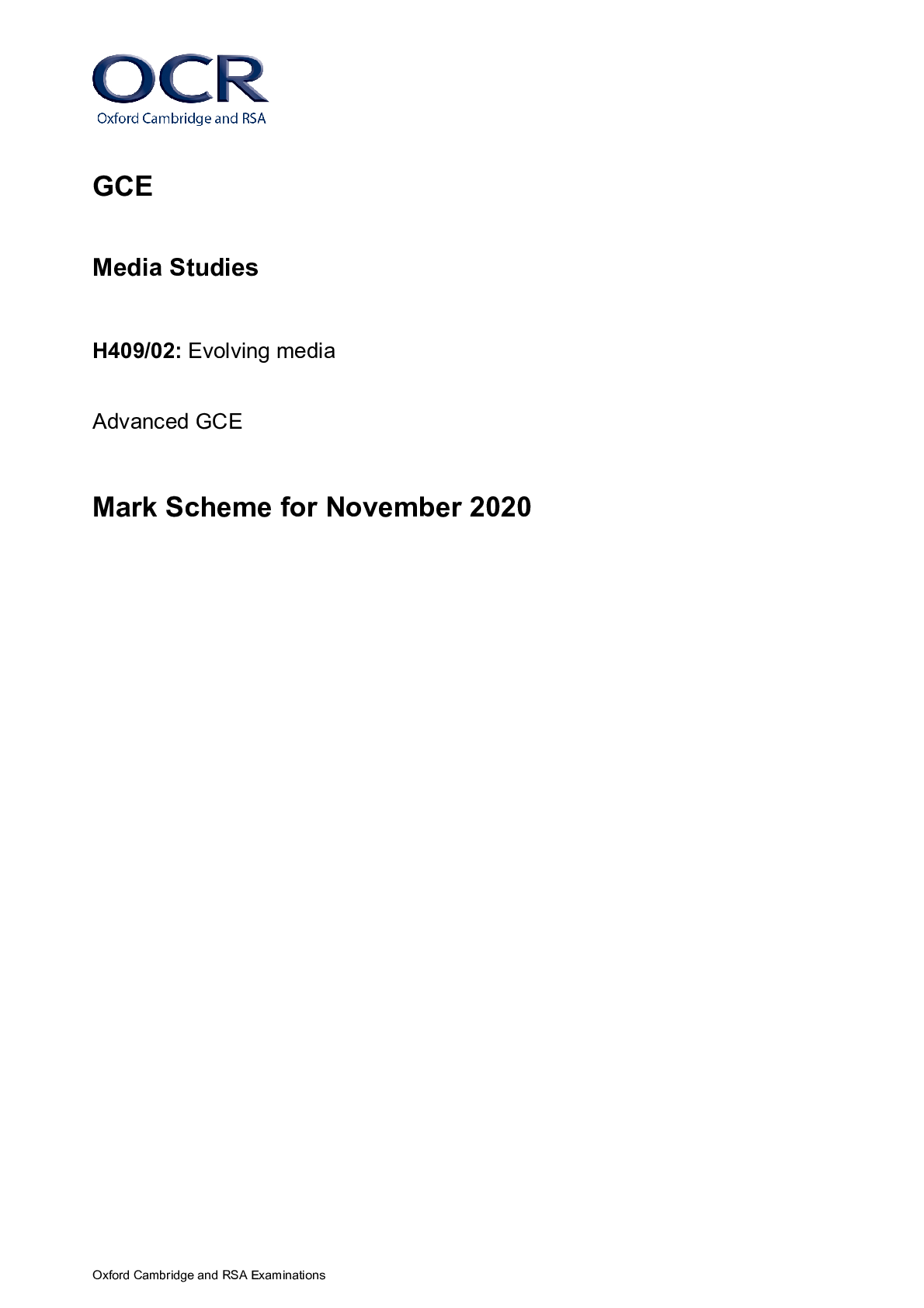
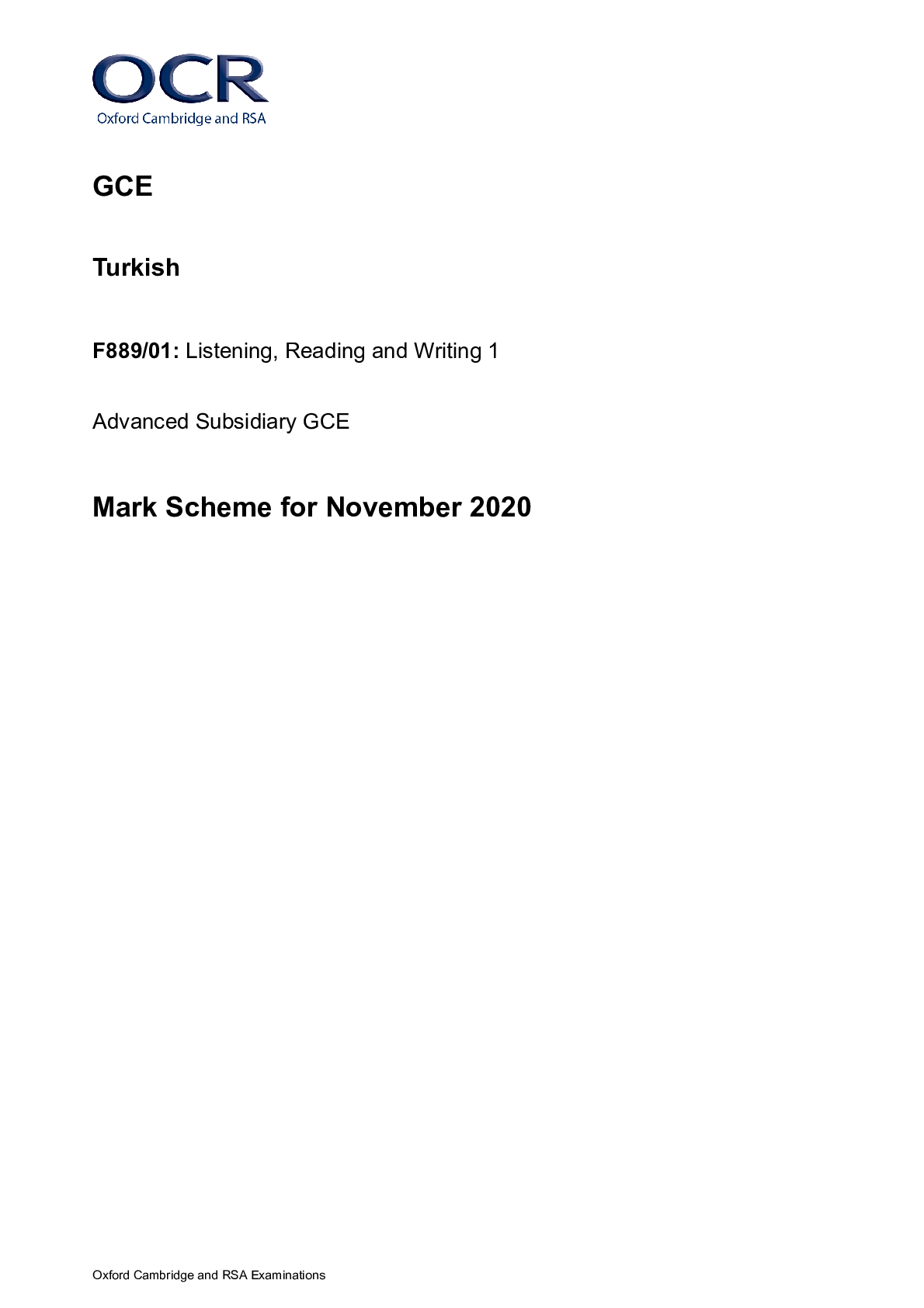
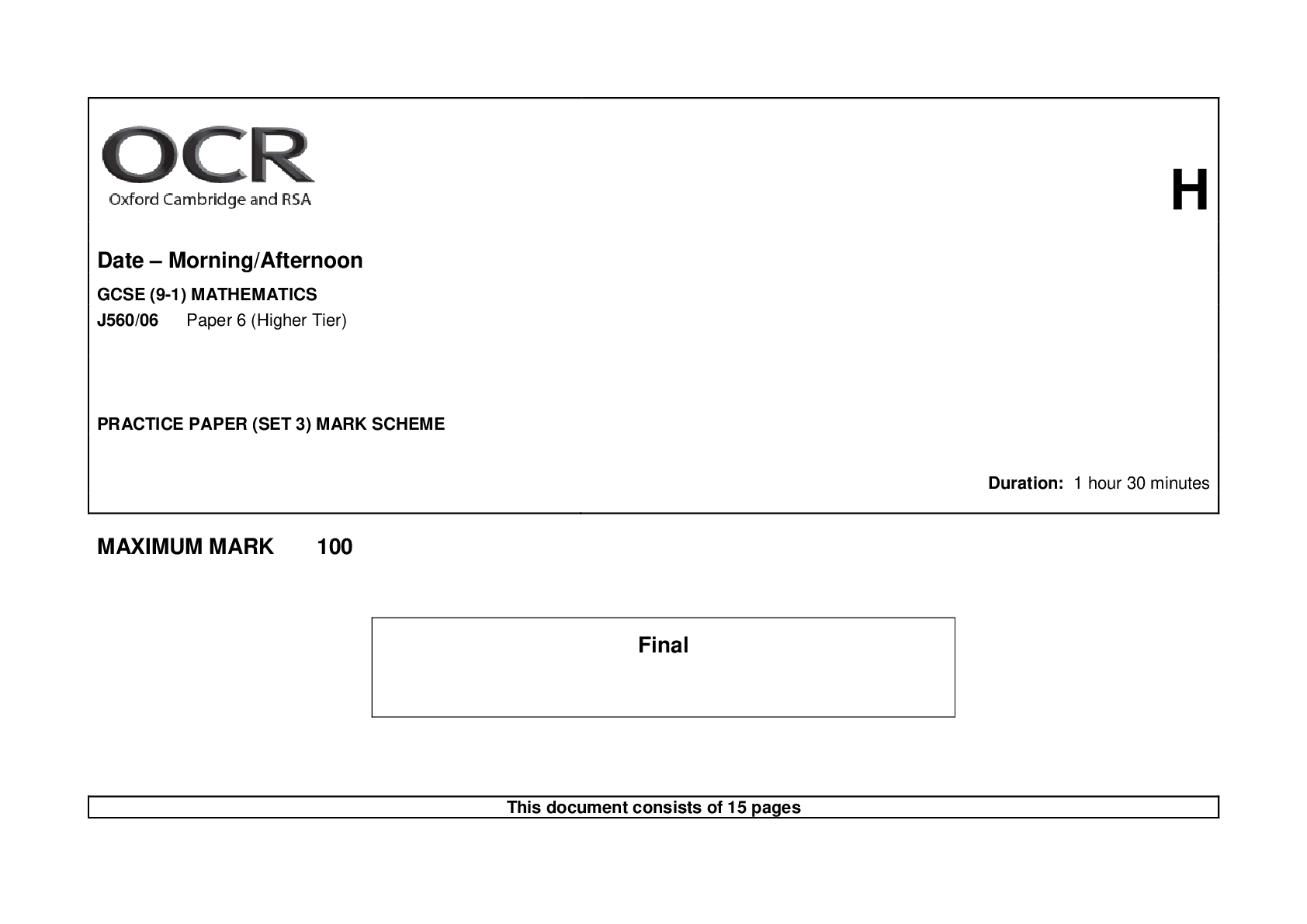


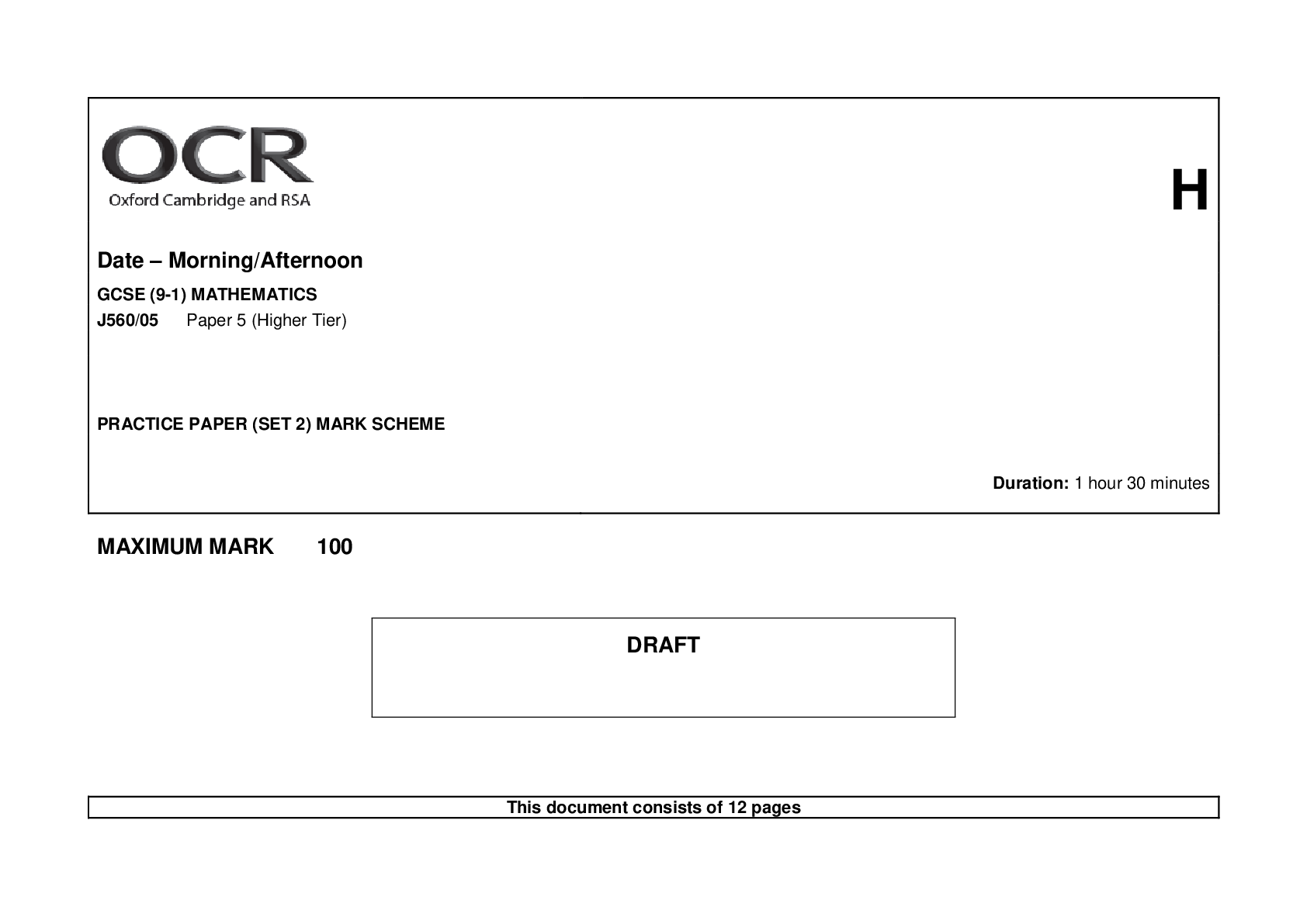
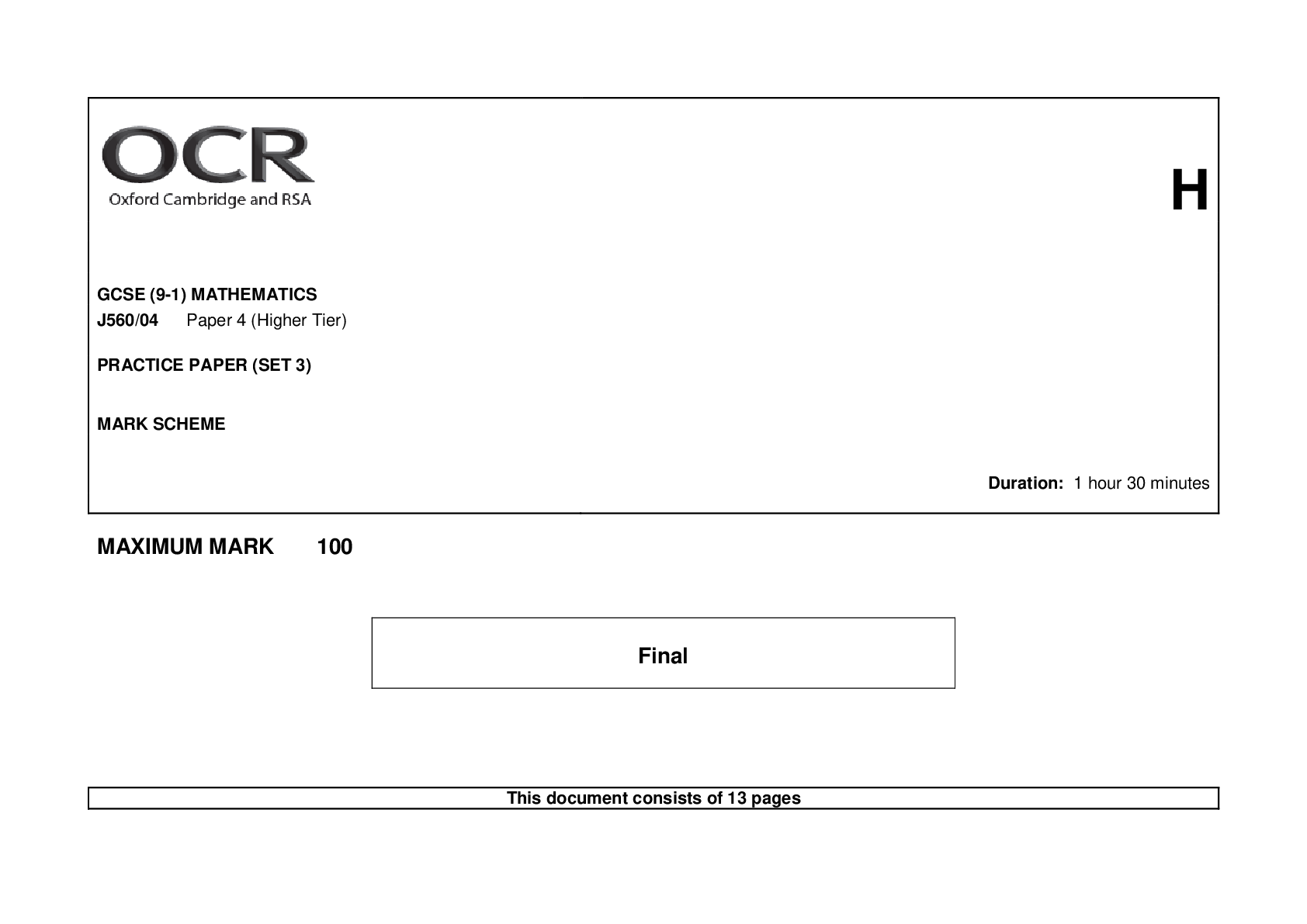



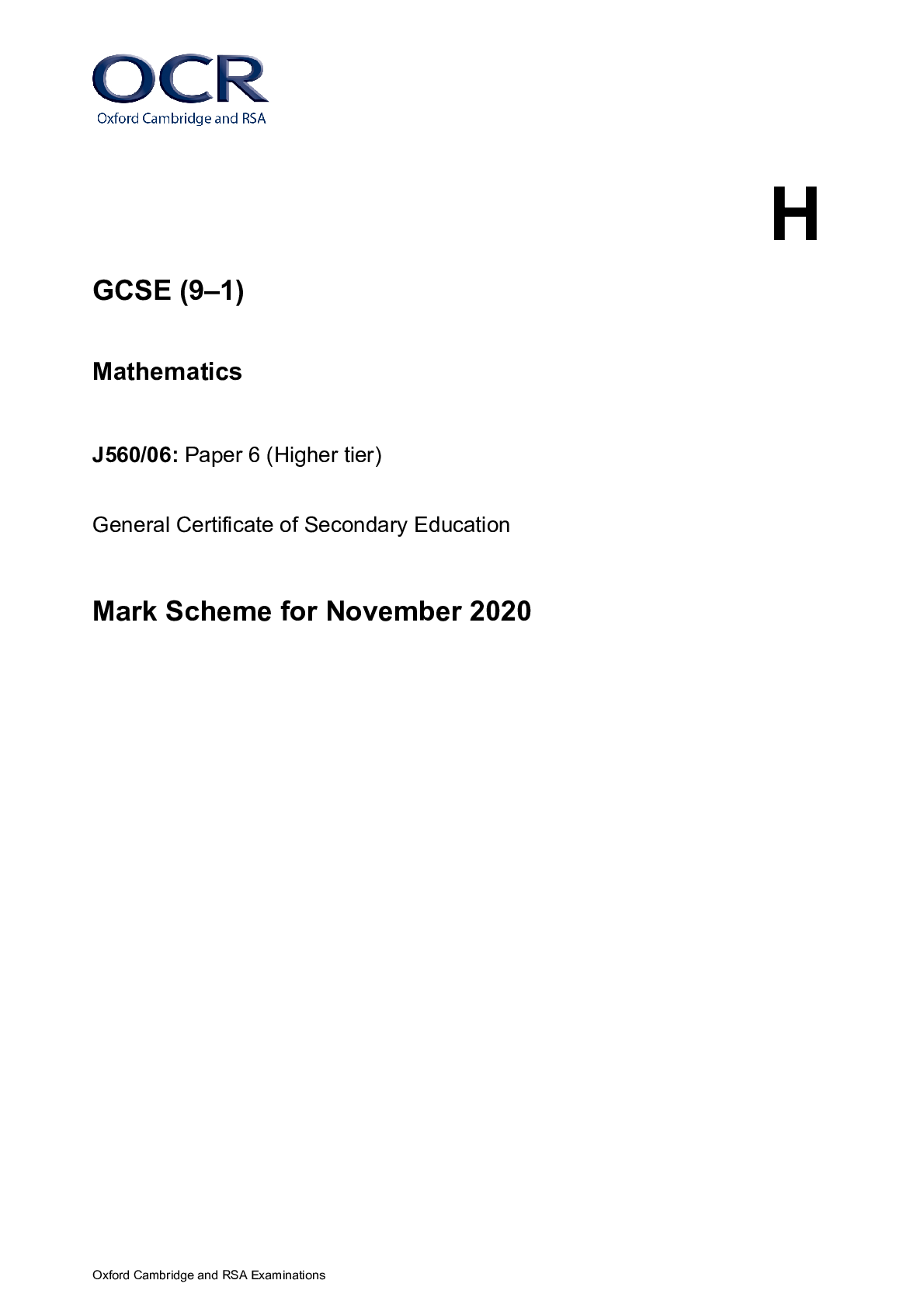
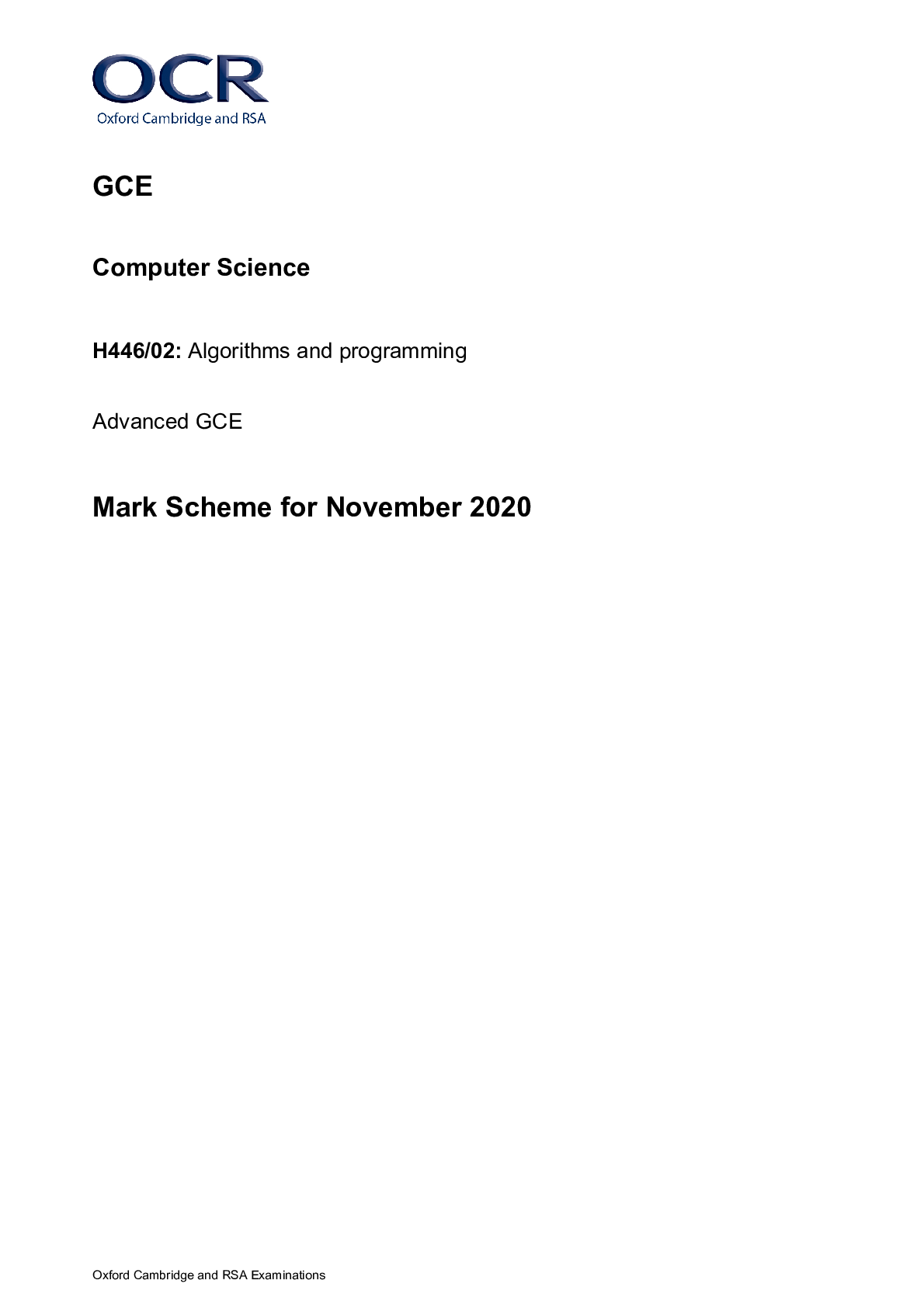
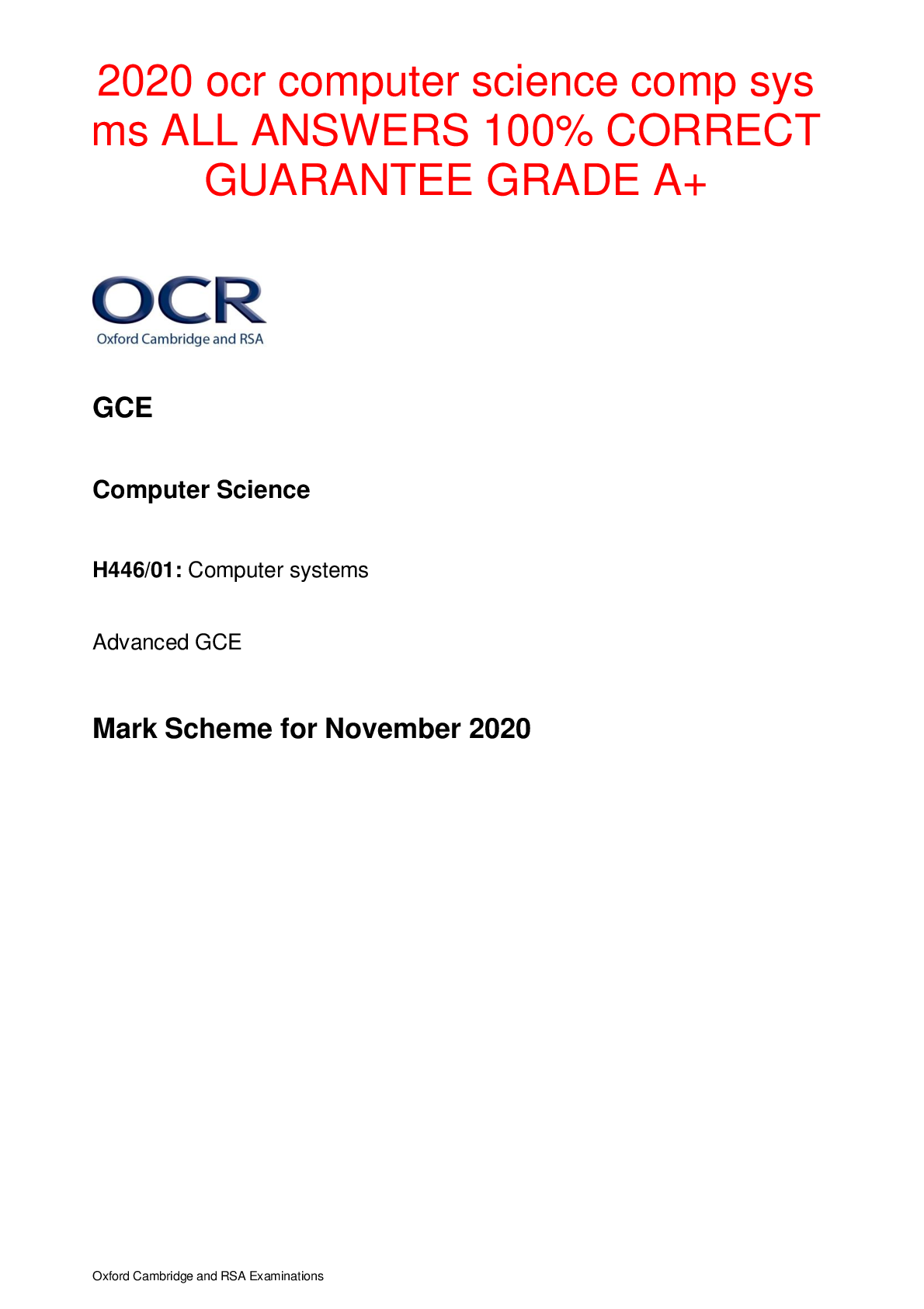

.png)
